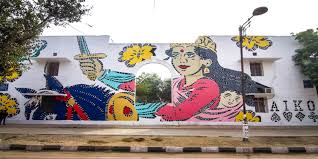
In Delhi, the city walls often speak louder than speeches. Over the past few years, political murals have emerged across neighborhoods, acting as a visual voice of dissent. Street artists are turning public spaces into platforms of protest—responding to policies, protests, and the pulse of the people.
From stark images of masked protestors to symbolic renditions of broken justice scales, the murals reflect frustration, hope, and resistance. These aren’t just decorations; they’re declarations. Many appear near university campuses, government buildings, or protest hotspots like Shaheen Bagh.
The anonymity of street art offers safety, allowing artists to express bold political statements without censorship. But it’s also temporary—many pieces are whitewashed quickly. Yet, photos circulate online, keeping the message alive.
What’s powerful is how accessible these messages are. You don’t need to enter a gallery or read a manifesto—just walk by a wall, and the story unfolds. These murals form part of a larger global trend where street art becomes activism.
In Delhi, the wall has become a canvas of consciousness. And in times of unrest, that canvas often says what others cannot.
